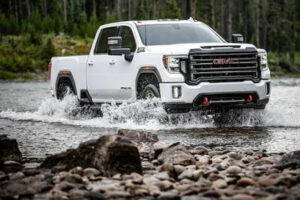 When you become faced with tricky road conditions like a loose grave, snowy hills, or slippery slopes, having a four-wheel drive can make you feel safe knowing that your vehicle can deliver power to all four wheels and use all available traction, increasing your chances of getting out of sticky situations.
When you become faced with tricky road conditions like a loose grave, snowy hills, or slippery slopes, having a four-wheel drive can make you feel safe knowing that your vehicle can deliver power to all four wheels and use all available traction, increasing your chances of getting out of sticky situations.
But it’s not enough to own a 4WD[note]https://en.wikipedia.org/wiki/Four-wheel_drive[/note], unfortunately. You need to understand your system and know when it’s time to use the correct setting so that you’re prepared for the journey ahead, especially if you live in an area where the weather can quickly go from zero to blizzard or if off-road conditions are a regular part of your life. By knowing your way around a 4×4, you prevent any damage to your vehicle and yourself.
So here’s a guide on engaging your GMC Sierra’s four-wheel drive. The Sierra is one of the most capable 4WD trucks today, but the truth is, any car is only as good as its driver.
The good news is that it doesn’t take long to learn when to engage the GMC Sierra’s four-wheel system[note]https://www.gmc.com/gmc-life/how-to/when-to-use-four-wheel-drive[/note]. So follow this guide to get a good grasp of how your truck works.
The best way to teach you how to operate your GMC Sierra’s four-wheel drive is by explaining the purpose of its various modes. I will also share tips and tricks of the trade to help you start your journey to become the pro 4WDer you want to be.
Table of Contents
How to Engage a Four-Wheel Drive GMC Sierra?
1. Two-High (2↑)
Also known as a two-wheel drive, 2-High is your GMC Sierra’s normal mode. You must at all times keep your truck at this setting when driving on paved, smooth roads because if there are no rough terrains, there’s no reason to engage the four-wheel drive system – you’ll only wear out your vehicle’s 4×4 mechanism.
In this setting, the transfer case sends power to the rear axle and rear wheels only.
[pt_view id=”226b138qc6″]
2. Four-High (4↑)
Best for slippery surfaces like snowy, icy, and muddy roads, this setting is where the transfer case sends engine power to both the front and rear axles and all four wheels of the truck, allowing better traction than 2-wheel drive.
GMC has designed their transfer cases to allow drivers to shift between 4-High and 2-High without bringing the vehicle to a stop.
3. Four-Low (4↓)
Four-Low is the setting designed for extremely slippery conditions like deep water, very steep slopes, boulders, heavy snow, thick mud, and deep sand. It provides double the torque sent to all four wheels, increasing your truck’s capability of conquering hellish terrains.
While in 4-Low mode, your GMC Sierra must be driven at slower speeds, specifically lower than 10mph and never over 45mph. Unlike the quick transition between 2-High and 4-High, you will need to shift the transmission to neutral and disconnect torque to put the truck at 4-Low from 4-High. Do the same process to shift the vehicle from 4-Low to 4-High.
4. Automatic 4-Wheel Drive
The Automatic 4×4 setting is a convenient way to cruise through road conditions that frequently switch from paved to rough. Here, the vehicle is in two-wheel drive while monitoring tire traction so that your Sierra can determine when to shift to four-wheel drive automatically. Automatic mode is great for surfaces that are a combination of pavement and snow, ice, grass, dirt, or mud. However, Automatic mode is not recommended for severe off-road conditions or heavy snow.
Four-Wheel Drive Tips and Tricks

Now that I’ve established the different four-wheel drive options let’s move on to driving tips and what to do in specific off-road situations.
1. Slow and steady is the way to go. A lot of drivers think it’s fine to drive their 4WDs fast on back roads. Going at speeds more than your Sierra can handle at 4-High or 4-Low mode may lead to unnecessary stress, both to yourself and your vehicle. The trick is to drive slowly and with control. Use momentum instead of speed to get you through rough patches. If you’re about to drive over a slippery patch of road or go down a steep hill, get your truck rolling before you reach the tricky terrain, and then let the moment from Sierra’s weight carry you to safety. Rocky terrain also requires a slow, leisurely pace so you can work your way through the terrain with precision.
2. Use momentum for sand driving. Driving over sand requires a good deal of momentum while at 4-High so you can speed your way through. If you feel the tires are starting to get buried, don’t floor it! That will only bury the truck further. Instead, stop, step out of the car, and help the truck find solid traction. Use a ramp, a wooden plank, or other hard surfaces.
3. Walk water crossings before driving across. You’ll never know if there’s a deep hole in what looks like a shallow stream unless you examine the area. Drive slowly as though you’re driving through rocky terrain – it’s the same except the rocks are underwater.
4. Go slow on snow. Icy, snowy surfaces need more stopping because traction is greatly reduced. If you drive as fast as you would on a sunny day, you might skid. So if you want to drive in snow without any issues, the trick is to drive like a grandma and doing one maneuver at a time. Reduce your speed then make a turn instead of braking while turning.
Anti-lock brakes (ABS) can help prevent the wheels from locking up into a skid but don’t rely on the ABS[note]https://cecas.clemson.edu/cvel/auto/AuE835_Projects_2011/Yin_Chen_project.html[/note] at all times. Apply the brakes slowly to avoid losing traction. And make sure to gear up. Snow tires will help you get more traction, and tire chains will reduce slipping.
5. Engage the four-wheel drive only when necessary. If you’re using the 4-Low and 4-High settings on roads with excellent traction, you’re placing unnecessary stress on the axles, transfer cases, and other 4×4 components, leading to faster wear and tear. The moment road conditions improve, switch out of 4-High and 4-Low mode.
6. Prepare your truck for the journey. Make sure your vehicle is at the optimal driving condition. Have it inspected by a mechanic regularly and check your fluids and brake pads.
7. Research and study the area. While the Sierra is designed for serious off-roading, you want to get a good idea of the terrain you’re about to brave. Buy or download maps. Watch online videos. Ask people familiar with the environment. These will help you visualize the road ahead and mentally prepare for the optimal speed and settings that will help you successfully overcome obstacles. Even if you’ve driven this road in the past, the elements or low maintenance may have altered road conditions.
8. Avoid overloading. Some people make the mistake of assuming their truck can handle mud or sand while carrying the entire family. You may need to reduce weight and make a few sacrifices to enjoy that camping trip or make it through a rough country. This also goes back to tip #7. Researching will help you gauge how many people to take and how much stuff to jam in the cargo bed.
9. Low tire pressure can make a huge difference. The reason is that low air pressure helps with traction on off-road trails, especially terrains with rocks, sand, mud, and other slippery obstacles. Lower air pressure allows your vehicle to have more surface area to touch, giving your truck more stability. Reducing air pressure also allows your tires to resist sharp objects and punctures.
10. Concentrate on the road. Paying close attention to the road can mean the difference between conquering the trail and slipping off the way because you didn’t notice a log in the grass. Make sure you are free of distractions while driving.
So there you have it. Driving a 4×4 smoothly requires confidence, skill, and experience, but I hope this guide will be your first step in mastering your GMC Sierra’s 4-wheel drive system. Happy driving days ahead!
